2017 MERCEDES-BENZ GLS steering
[x] Cancel search: steeringPage 225 of 390
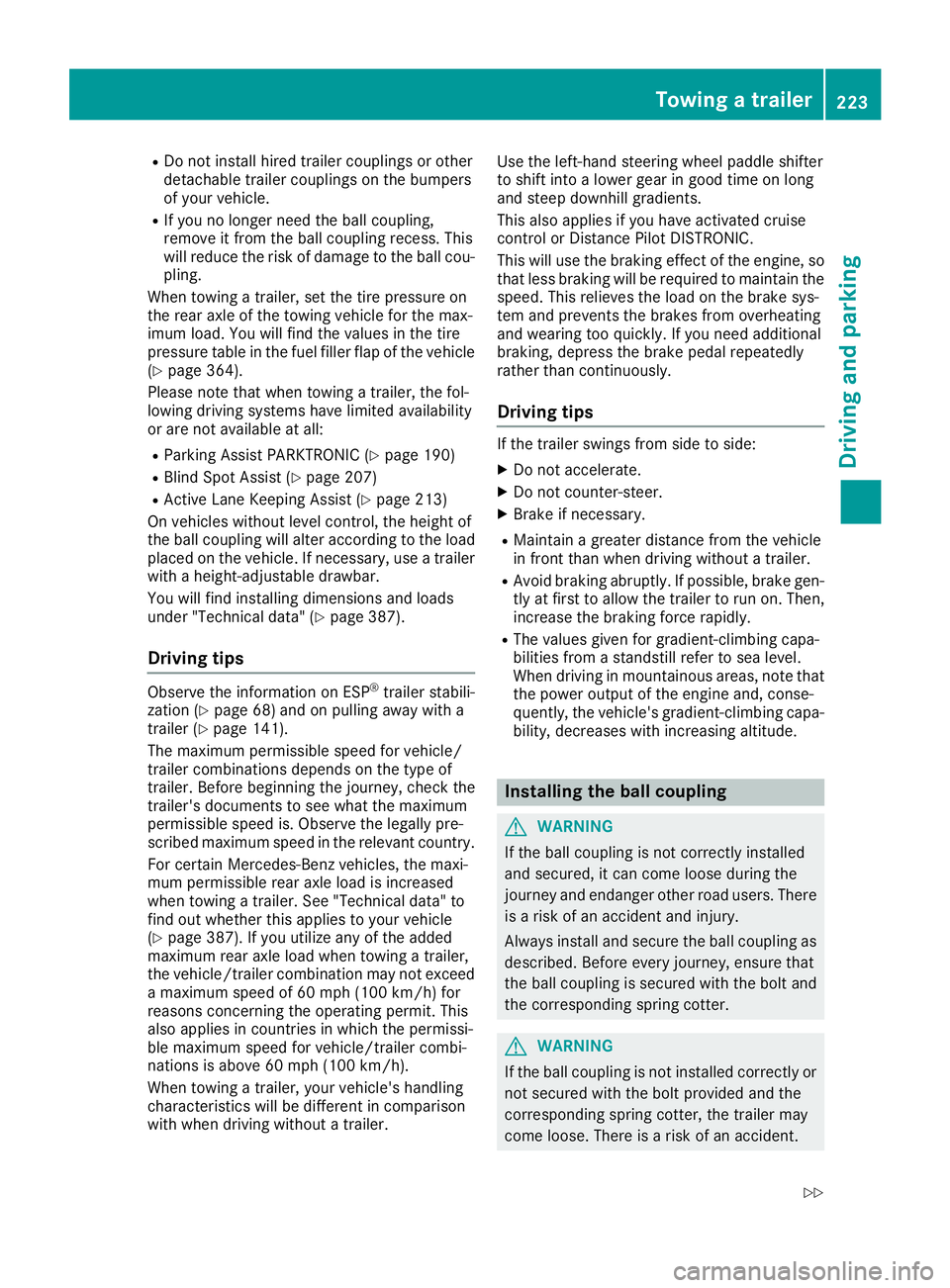
R
Do not install hired trailer couplings or other
detachable trailer couplings on the bumpers
of your vehicle. R
If you no longer need the ball coupling,
remove it from the ball coupling recess. This
will reduce the risk of damage to the ball cou-
pling.
When towing a trailer, set the tire pressure on
the rear axle of the towing vehicle for the max-
imum load. You will find the values in the tire
pressure table in the fuel filler flap of the vehicle
( Y
page 364).
Please note that when towing a trailer, the fol-
lowing driving systems have limited availability
or are not available at all: R
Parking Assist PARKTRONIC ( Y
page 190)R
Blind Spot Assist ( Y
page 207)R
Active Lane Keeping Assist ( Y
page 213)
On vehicles without level control, the height of
the ball coupling will alter according to the load
placed on the vehicle. If necessary, use a trailer
with a height-adjustable drawbar.
You will find installing dimensions and loads
under "Technical data" ( Y
page 387).
Driving tips Observe the information on ESP ®
trailer stabili-
zation ( Y
page 68) and on pulling away with a
trailer ( Y
page 141).
The maximum permissible speed for vehicle/
trailer combinations depends on the type of
trailer. Before beginning the journey, check the
trailer's documents to see what the maximum
permissible speed is. Observe the legally pre-
scribed maximum speed in the relevant country.
For certain Mercedes-Benz vehicles, the maxi-
mum permissible rear axle load is increased
when towing a trailer. See "Technical data" to
find out whether this applies to your vehicle
( Y
page 387). If you utilize any of the added
maximum rear axle load when towing a trailer,
the vehicle/trailer combination may not exceed
a maximum speed of 60 mph (100 km/h) for
reasons concerning the operating permit. This
also applies in countries in which the permissi-
ble maximum speed for vehicle/trailer combi-
nations is above 60 mph (100 km/h).
When towing a trailer, your vehicle's handling
characteristics will be different in comparison
with when driving without a trailer. Use the left-hand steering wheel paddle shifter
to shift into a lowe r g ear in good time on long
a
nd steep downhill gradients.
This also applies if you have activated cruise
control or Distance Pilot DISTRONIC.
This will use the braking effect of the engine, so
that less braking will be required to maintain the
speed. This relieves the load on the brake sys-
tem and prevents the brakes from overheating
and wearing too quickly. If you need additional
braking, depress the brake pedal repeatedly
rather than continuously.
Driving tips If the trailer swings from side to side: X
Do not accelerate. X
Do not counter-steer. X
Brake if necessary. R
Maintain a greater distance from the vehicle
in front than when driving without a trailer. R
Avoid braking abruptly. If possible, brake gen-
tly at first to allow the trailer to run on. Then,
increase the braking force rapidly. R
The values given for gradient-climbing capa-
bilities from a standstill refer to sea level.
When driving in mountainous areas, note that
the power output of the engine and, conse-
quently, the vehicle's gradient-climbing capa-
bility, decreases with increasing altitude.
Installing the ball coupling
G WARNING
If the ball coupling is not correctly installed
and secured, it can come loose during the
journey and endanger other road users. There
is a risk of an accident and injury.
Always install and secure the ball coupling as
described. Before every journey, ensure that
the ball coupling is secured with the bolt and
the corresponding spring cotter.
G WARNING
If the ball coupling is not installed correctly or
not secured with the bolt provided and the
corresponding spring cotter, the trailer may
come loose. There is a risk of an accident.Towing a trailer 223
Driving an d parking Z
Page 228 of 390

Towing a trailer There are numerous legal requirements con-
cerning the towing of a trailer, e.g. speed restric-
tions. Make sure that your car/trailer combina-
tion complies with the local regulations: R
in your place of residence R
in the location to which you are driving
The police and local authorities can provide reli-
able information.
Observe the following when towing a trailer: R
To gain driving experience and to become
accustomed to the new handling characteris-
tics, you should practice the following in a
traffic-free location: -
cornering -
stopping -
backing up R
Before driving, check: -
trailer tow hitch -
safety switch for braked trailers -
safety chains -
electrical connections -
lights -
wheels R
Adjust the exterior mirrors to provide an
unobstructed view of the rear section of the
trailer. R
If the trailer has electronically controlled
brakes, pull away carefully. Brake manually
using the brake controller and check whether
the brakes function correctly. R
Secure any objects on the trailer to prevent
the cargo from slipping when the vehicle is in
motion. R
When you couple up a trailer, check at regular
intervals that the load is firmly secured. If the
tra i ler is equipped with trailer lights and
brakes, check the trailer to ensure that these
are working. R
Bear in mind that the handling will be less
stable when towing a trailer than when driving
without one. Avoid sudden steering move-
ments. R
The vehicle/trailer combination is heavier,
accelerates more slowly, has a decreased
gradient climbing capability and a longer
braking distance.
It is more susceptible to side winds and
requires more careful steering. R
If possible, do not brake suddenly, but instead
depress the brake pedal moderately at first so
that the trailer can activate its brakes. Then
increase the pressure on the brake pedal. R
If the automatic transmission repeatedly
shifts between gears on uphill or downhill gra-
dients, shift to a lower gear using the left-hand
steering wheel paddle shifter.
A lower gear and lower speed reduce the risk
of engine failure. R
When driving downhill, shift to a lower gear to
utilize the engine's braking effect.
Avoid continuous brake application as this
may overheat the vehicle brakes and, if instal-
led, the trailer brakes. R
If the coolant temperature increases dramat-
i cally while the air-conditioning system is
switched on, switch off the air-conditioning
system.
Coolant heat can also be dissipated by open-
ing the windows and switching the ventilation
blower and the interior temperature to the
highest level. R
When overtaking, pay particular attention to
the extended length of your vehicle/trailer
combination.
Due to the length of the vehicle/trailer com-
bination, you require additional road space in
relation to the vehicle you are overtaking
before you can change back to the original
lane.
Decoupling a trailer
G WARNING
If you uncouple a trailer with the overrun
brake engaged, you could trap your hand
between the vehicle and the trailer drawbar.
There is a risk of injury.
Do not uncouple a trailer if the overrun brake
is engaged.
G WARNING
Vehicles with level control:
The vehicle is lowered as soon as you discon-
nect the trailer cable. This could result in your
limbs or those of other people that are
between the vehicle body and tires or under-226
Towing a trailer
Driving an d parking
Page 237 of 390
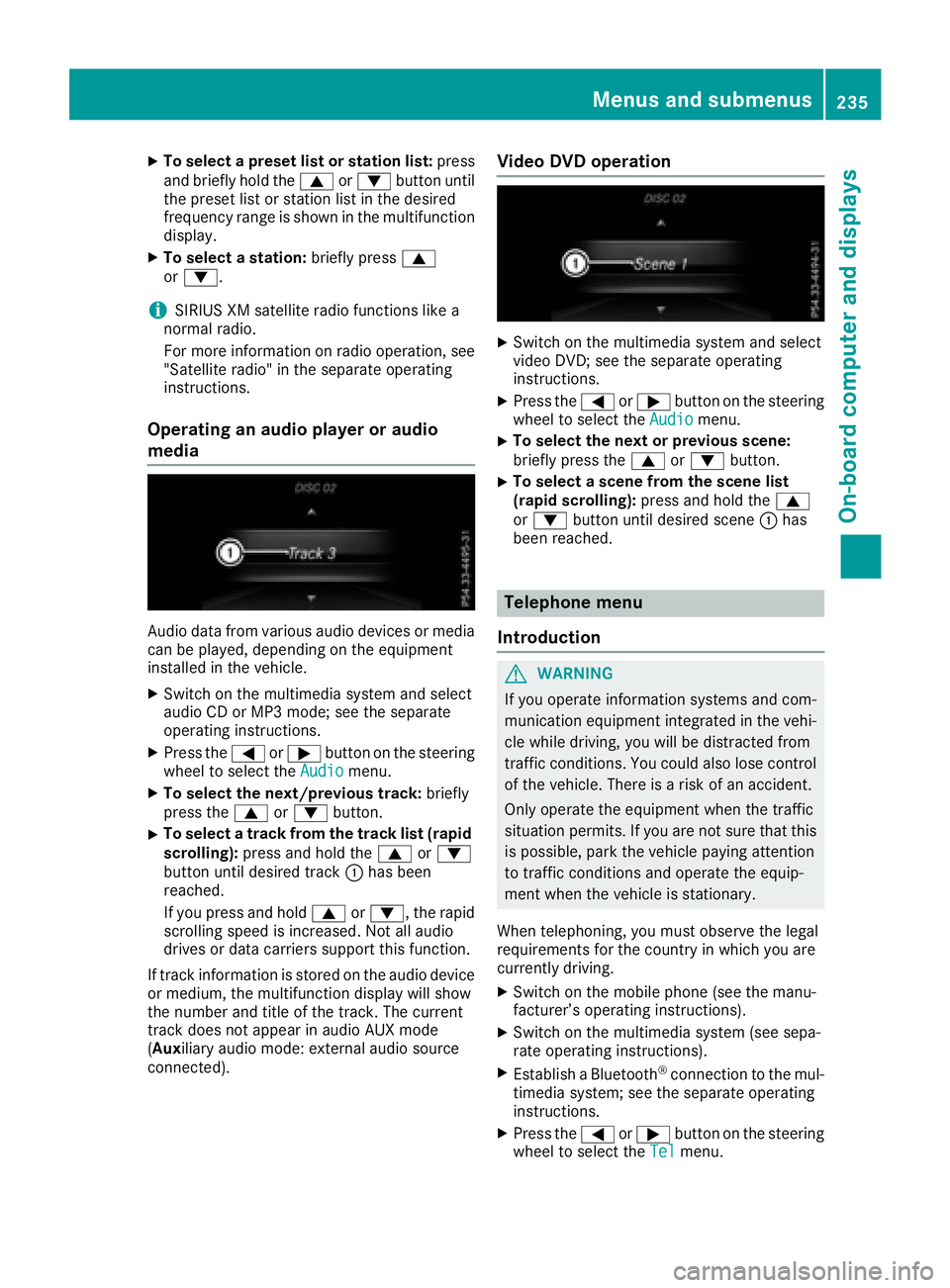
X
To select a preset list or station list: press
and briefly hold the �c or �d button until
the preset list or station list in the desired
frequency range is shown in the multifunction
display. X
To select a station: briefly press �c
or �d .
i SIRIUS XM satellite radio functions like a
normal radio.
For more information on radio operation, see
"Satellite radio" in the separate operating
instructions.
Operating an audio player or audio
media
Audio data from various audio devices or media
can be played, depending on the equipment
installed in the vehicle. X
Switch on the multimedia system and select
audio CD or MP3 mode; see the separate
operating instructions. X
Press the �Y or �e button on the steering
wheel to select the Audio menu.X
To select the next/previous track: briefly
press the �c or �d button.X
To select a track from the track list (rapid
scrolling): press and hold the �c or �d
button until desired track �C has been
reached.
If you press and hold �c or �d , the rapid
scrolling speed is increased. Not all audio
drives or data carriers support this function.
If track information is stored on the audio device
or medium, the multifunction display will show
the number and title of the track. The current
track does not appear in audio AUX mode
( Aux iliary audio mode: external audio source
connected). Video DVD operation X
Switch on the multimedia system and select
video DVD; see the separate operating
instructions. X
Press the �Y or �e button on the steering
wheel to select the Audio menu.X
To select the next or previous scene:
briefly press the �c or �d button.X
To select a scene from the scene list
(rapid scrolling): press and hold the �c
or �d button until desired scene �C has
been reached.
Telephone menu
Introduction
G WARNING
If you operate information systems and com-
munication equipment integrated in the vehi-
cle while driving, you will be distracted from
traffic conditions. You could also lose control
of the vehicle. There is a risk of an accident.
Only operate the equipment when the traffic
situation permits. If you are not sure that this
is possible, park the vehicle paying attention
to traffic conditions and operate the equip-
ment when the vehicle is stationary.
When telephoning, you must observe the legal
requirements for the country in which you are
currently driving. X
Switch on the mobile phone (see the manu-
facturer’s operating instructions). X
Switch on the multimedia system (see sepa-
rate operating instructions). X
Establish a Bluetooth ®
connection to the mul-
timedia system; see the separate operating
instructions. X
Press the �Y or �e button on the steering
wheel to select the Tel menu.Menus and submenus 235
On-board computer and displays Z
Page 238 of 390
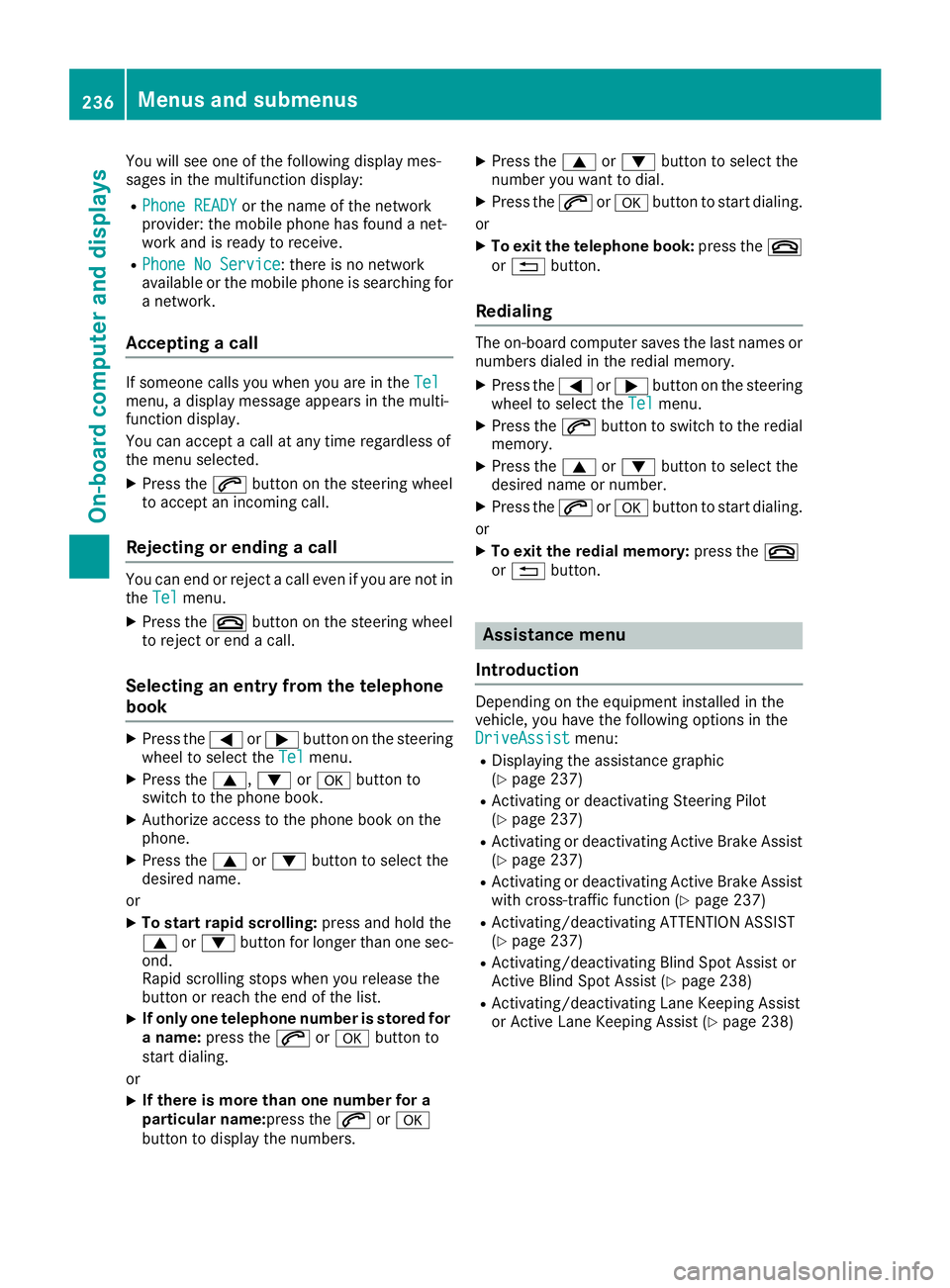
You will see one of the following display mes-
sages in the multifunction display: R
Phone READY or the name of the network
provider: the mobile phone has found a net-
work and is ready to receive. R
Phone No Service : there is no network
available or the mobile phone is searching for
a network.
Accepting a call If someone calls you when you are in the Tel
menu, a display message appears in the multi-
function display.
You can accept a call at any time regardless of
the menu selected. X
Press the �a button on the steering wheel
to accept an incoming call.
Rejecting or ending a call You can end or reject a call even if you are not in
the Tel menu.X
Press the �v button on the steering wheel
to reject or end a call.
Selecting an entry from the telephone
book X
Press the �Y or �e button on the steering
wheel to select the Tel menu.X
Press the �c , �d or �v button to
switch to the phone book. X
Authorize access to the phone book on the
phone. X
Press the �c or �d button to select the
desired name.
or X
To start rapid scrolling: press and hold the
�c or �d button for longer than one sec-
ond.
Rapid scrolling stops when you release the
button or reach the end of the list. X
If only one telephone number is stored for
a name: press the �a or �v button to
start dialing.
or X
If there is more than one number for a
particular name: press the �a or �v
button to display the numbers. X
Press the �c or �d button to select the
number you want to dial. X
Press the �a or �v button to start dialing.
or X
To exit the telephone book: press the �v
or �8 button.
Redialing The on-board computer saves the last names or
numbers dialed in the redial memory. X
Press the �Y or �e button on the steering
wheel to select the Tel menu.X
Press the �a button to switch to the redial
memory. X
Press the �c or �d button to select the
desired name or number. X
Press the �a or �v button to start dialing.
or X
To exit the redial memory: press the �v
or �8 button.
Assistance menu
Introduction Depending on the equipment installed in the
vehicle, you have the following options in the
DriveAssist menu: R
Displaying the assistance graphic
( Y
page 237) R
Activating or deactivating Steering Pilot
( Y
page 237) R
Activating or deactivating Active Brake Assist
( Y
page 237) R
Activating or deactivating Active Brake Assist
with cross-traffic function ( Y
page 237)R
Activating/deactivating ATTENTION ASSIST
( Y
page 237) R
Activating/deactivating Blind Spot Assist or
Active Blind Spot Assist ( Y
page 238)R
Activating/deactivating Lane Keeping Assist
or Active Lane Keeping Assist ( Y
page 238)236
Menus and submenus
On-board computer and displays
Page 239 of 390
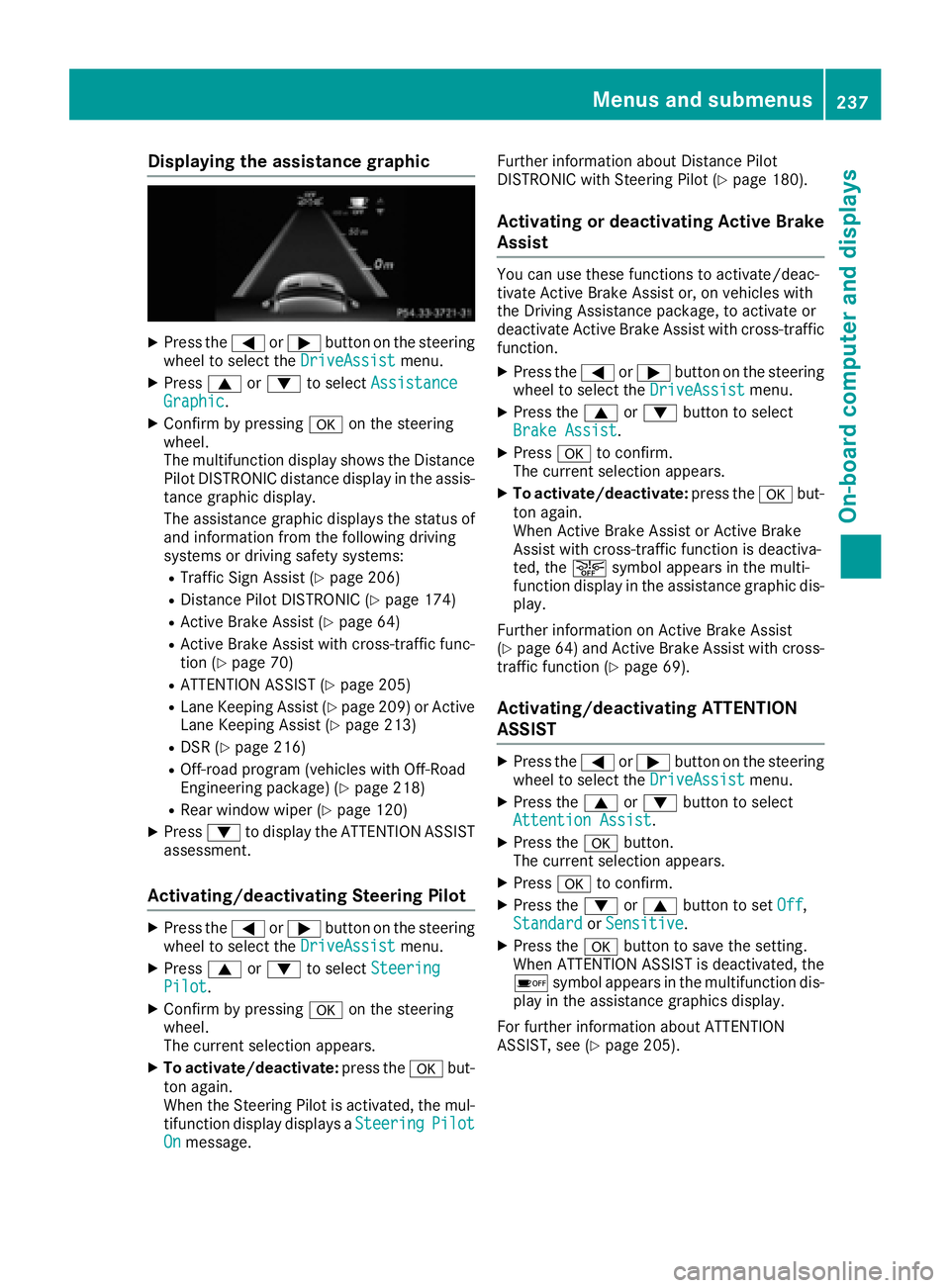
Displaying th e assistance graphicX
Press th e �Y or �e butto n on th e steerin g
whee l to selec t th e DriveAssist menu.X
Press �c or �d to selec t Assistanc e
Graphi c .X
Confir m by pressing �v on th e steerin g
wheel.
The multifunction display shows th e Distanc e
Pilo t DISTRONIC distanc e display in th e assis-
tanc e graphi c display.
The assistanc e graphi c displays th e status of
and information from th e followin g drivin g
systems or drivin g safet y systems :R
Traffic Sign Assis t ( Y
page 206)R
Distanc e Pilo t DISTRONIC ( Y
page 174)R
Active Brak e Assis t ( Y
page 64)R
Active Brak e Assis t wit h cross-traffic func-
tion ( Y
page 70 )R
ATTENTION ASSIST ( Y
page 205)R
Lan e Keepin g Assis t ( Y
page 209) or Active
Lan e Keepin g Assis t ( Y
page 213)R
DS R ( Y
page 216)R
Off-road program (vehicles wit h Off-Road
Engineerin g package) ( Y
page 218)R
Rear window wipe r ( Y
page 120)X
Press �d to display th e ATTENTION ASSIST
assessment.
Activating/deactivating Steering Pilo tX
Press th e �Y or �e butto n on th e steerin g
whee l to selec t th e DriveAssist menu.X
Press �c or �d to selec t Steering
Pilot .X
Confir m by pressing �v on th e steerin g
wheel.
The curren t selection appears .X
To activate/deactivate : press th e �v but -
to n again .
Whe n th e Steerin g Pilo t is activated, th e mul-
tifunction display displays a Steering Pilot
On message. Further information about Distanc e Pilo t
DISTRONIC wit h Steerin g Pilo t ( Y
page 180).
Activating or deactivating Active Brak e
Assis t You can use these function s to activate/deac -
tivat e Active Brak e Assis t or , on vehicles wit h
th e Driving Assistanc e package, to activat e or
deactivat e Active Brak e Assis t wit h cross-traffic
function . X
Press th e �Y or �e butto n on th e steerin g
whee l to selec t th e DriveAssist menu.X
Press th e �c or �d butto n to selec t
Brake Assist . X
Press �v to confirm .
The curren t selection appears .X
To activate/deactivate : press th e �v but -
to n again .
Whe n Active Brak e Assis t or Active Brak e
Assis t wit h cross-traffic function is deactiva-
ted, th e �
Page 240 of 390
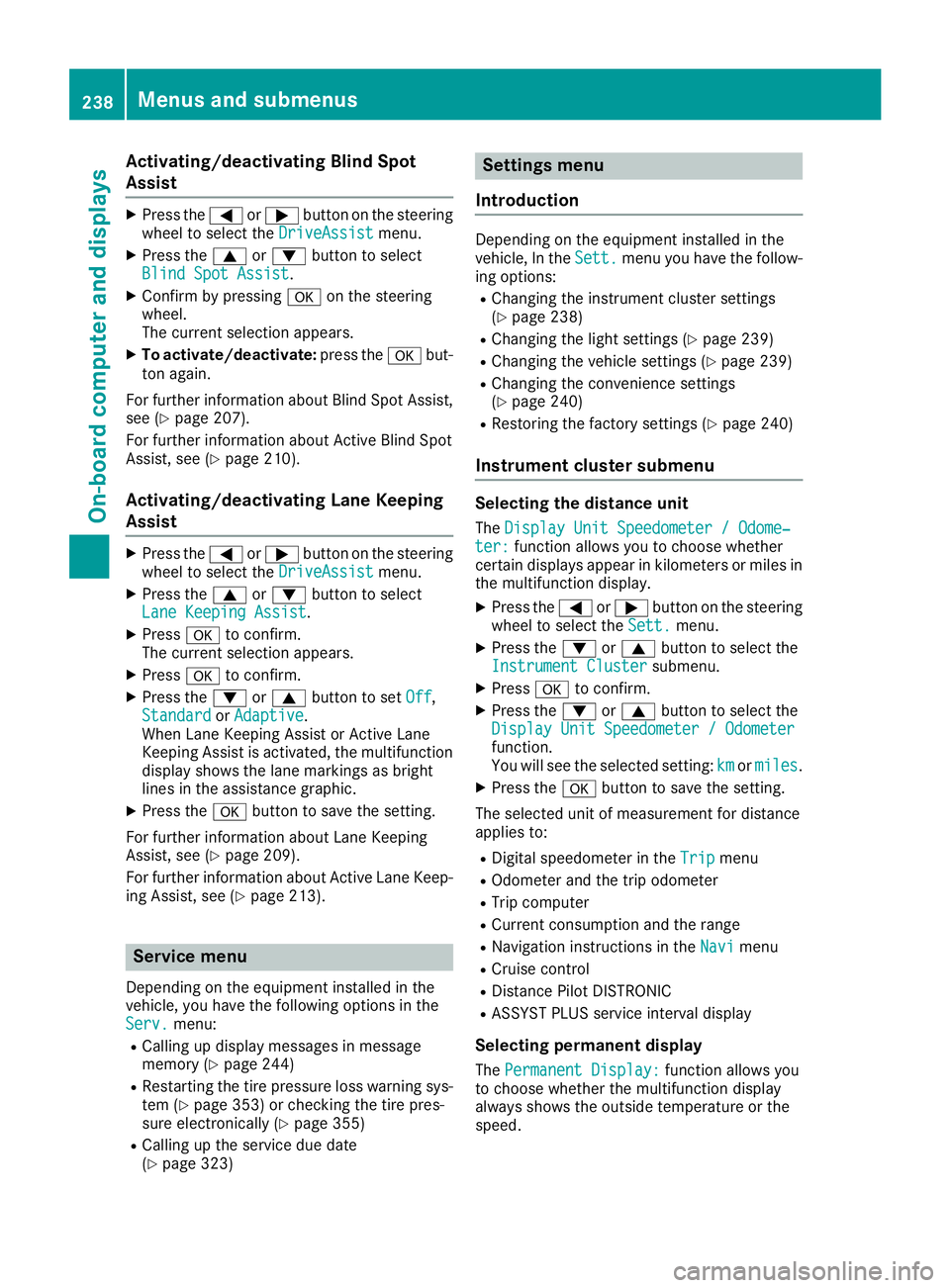
Activating/deactivating Blind Sp ot
Assist X
Press th e �Y or �e butto n on th e steering
whee l to select th e DriveAssist menu.X
Press th e �c or �d butto n to select
Blind Spo t Assist .X
Confir m by pressing �v on th e steering
wheel.
The curren t selection appears.X
To activate/deactivate: press th e �v but -
to n again .
Fo r further information about Blind Spot Assist,
see ( Y
page 207).
Fo r further information about Active Blind Spot
Assist, see ( Y
page 210).
Activating/deactivating Lane Keeping
Assist X
Press th e �Y or �e butto n on th e steering
whee l to select th e DriveAssist menu.X
Press th e �c or �d butto n to select
Lan e Keepin g Assist .X
Press �v to confirm .
The curren t selection appears.X
Press �v to confirm .X
Press th e �d or �c butto n to set Off ,
Standard or Adaptive .
When Lan e Keepin g Assis t or Active Lan e
Keepin g Assis t is activated, th e multifunction
display shows th e lan e marking s as bright
lines in th e assistanc e graphic .X
Press th e �v butto n to sav e th e setting .
Fo r further information about Lan e Keepin g
Assist, see ( Y
page 209).
Fo r further information about Active Lan e Keep-
ing Assist, see ( Y
page 213).
Service menu Dependin g on th e equipmen t installed in th e
vehicle, you hav e th e followin g option s in th e
Serv. menu:R
Callin g up display message s in message
memory ( Y
page 244)R
Restarting th e tire pressur e loss warning sys-
te m ( Y
page 353) or checking th e tire pres-
sur e electronically ( Y
page 355)R
Callin g up th e servic e due dat e
( Y
page 323) Settings menu
Int rod uction Dependin g on th e equipmen t installed in th e
vehicle, In th e Sett. men u you hav e th e follow-
ing options: R
Changin g th e instrumen t cluste r setting s
( Y
page 238) R
Changin g th e ligh t setting s ( Y
page 239)R
Changin g th e vehicl e setting s ( Y
page 239)R
Changin g th e convenience setting s
( Y
page 240) R
Restoring th e factory setting s ( Y
page 240)
Inst ru ment cluster submenuSelecting th e distance uni tThe Displa y Uni t Speedometer / Odome‐
ter : function allows you to choos e whether
certain displays appear in kilometers or mile s in
th e multifunction display. X
Press th e �Y or �e butto n on th e steering
whee l to select th e Sett. menu.X
Press th e �d or �c butto n to select th e
Instrumen t Cluste r submenu.X
Press �v to confirm .X
Press th e �d or �c butto n to select th e
Displa y Uni t Speedometer / Odometer
function .
You will see th e selected setting : km or miles .X
Press th e �v butto n to sav e th e setting .
The selected uni t of measuremen t for distanc e
applie s to : R
Digital speedometer in th e Tri p men uR
Odometer and th e trip odometerR
Tri p computer R
Curren t consumption and th e rangeR
Navigation instruction s in th e Nav i men uR
Cruis e control R
Distanc e Pilo t DISTRONI CR
ASSYS T PLU S servic e interval display
Selecting permanent displa y
The Permanent Display: function allows you
to choos e whether th e multifunction display
always shows th e outside temperature or th e
speed.238
Menus and submenus
On-board computer and displays
Page 241 of 390
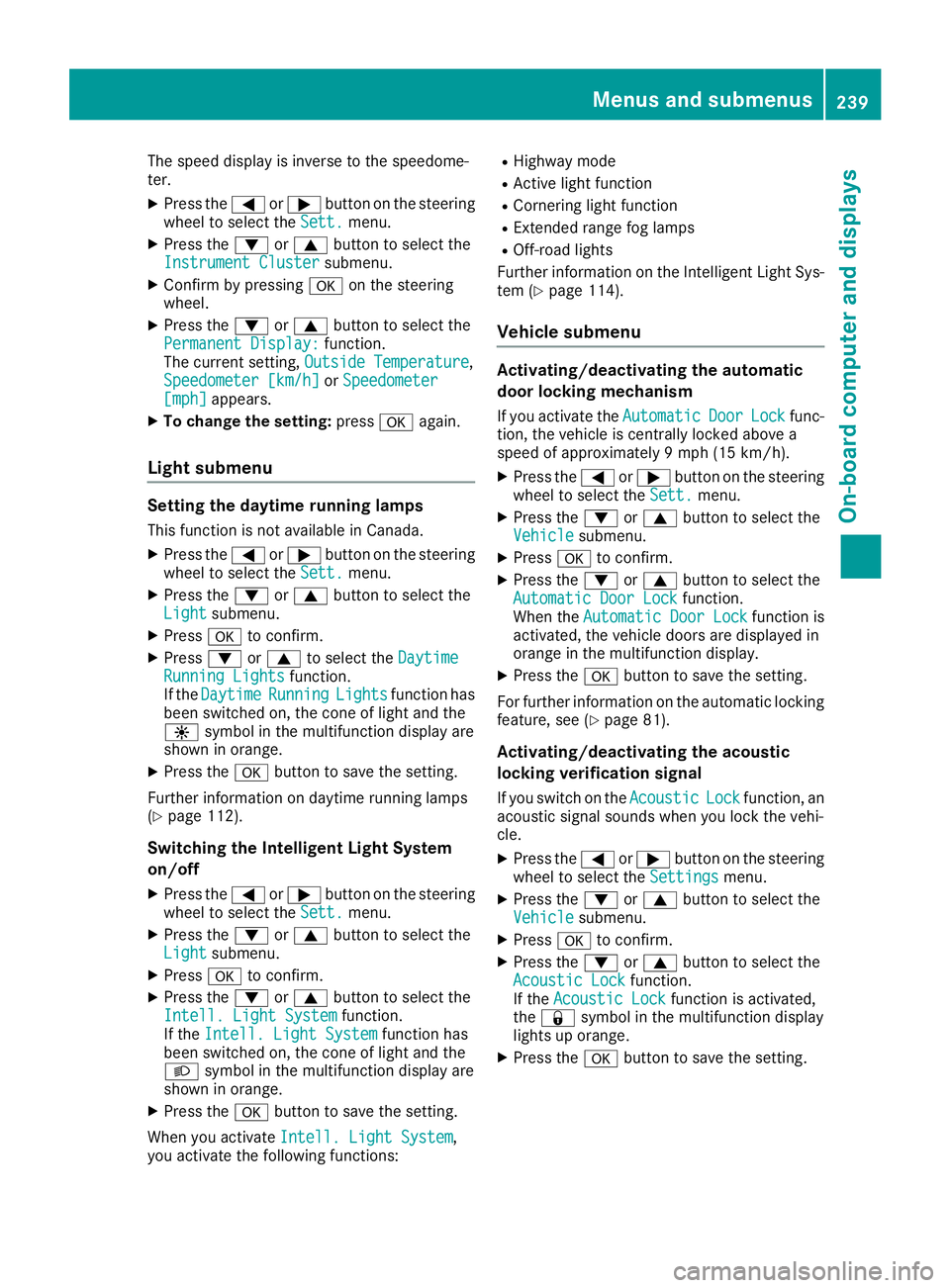
The speed display is inverse to the speedome-
ter. X
Press the �Y or �e button on the steering
wheel to select the Sett. menu.X
Press the �d or �c button to select the
Instrument Cluster submenu.X
Confirm by pressing �v on the steering
wheel. X
Press the �d or �c button to select the
Permanent Display: function.
The current setting, Outside Temperature ,
Speedometer [km/h] or Speedometer
[mph] appears.X
To change the setting: press �v again.
Light submenu Setting the daytime running lamps This function is not available in Canada. X
Press the �Y or �e button on the steering
wheel to select the Sett. menu.X
Press the �d or �c button to select the
Light submenu.X
Press �v to confirm.X
Press �d or �c to select the Daytime
Running Lights function.
If the Daytime Running Lights function has
been switched on, the cone of light and the
�
Page 242 of 390
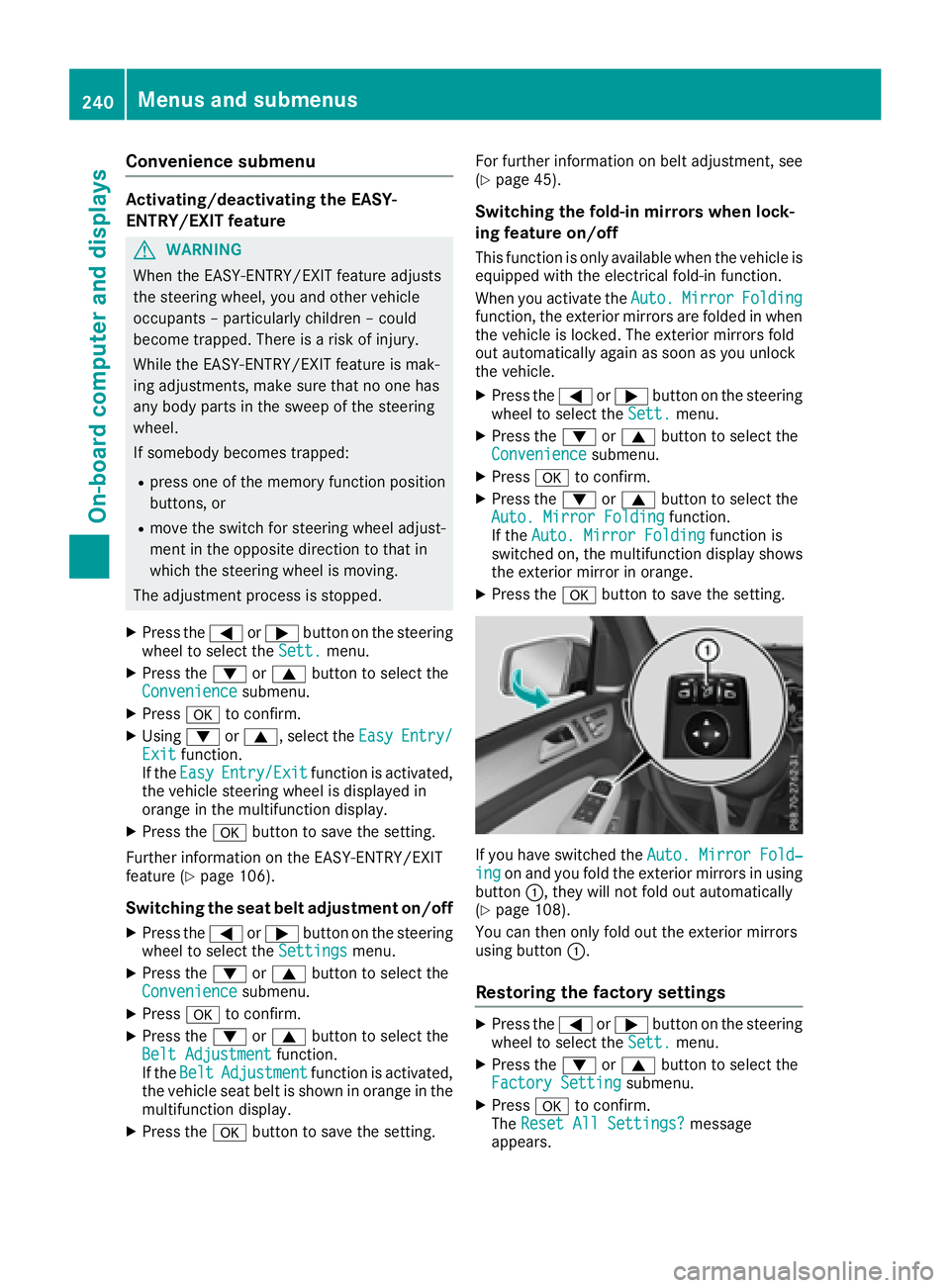
Convenience submenu Activating/deactivating the EASY-
ENTRY/EXIT feature
G WARNING
When the EASY-ENTRY/EXIT feature adjusts
the steering wheel, you and other vehicle
occupants – particularly children – could
become trapped. There is a risk of injury.
While the EASY-ENTRY/EXIT feature is mak-
ing adjustments, make sure that no one has
any body parts in the sweep of the steering
wheel.
If somebody becomes trapped: R
press one of the memory function position
buttons, or R
move the switch for steering wheel adjust-
ment in the opposite direction to that in
which the steering wheel is moving.
The adjustment process is stopped. X
Press the �Y or �e button on the steering
wheel to select the Sett. menu.X
Press the �d or �c button to select the
Convenience submenu.X
Press �v to confirm.X
Using �d or �c , select the Easy Entry/
Exit function.
If the Easy Entry/Exit function is activated,
the vehicle steering wheel is displayed in
orange in the multifunction display. X
Press the �v button to save the setting.
Further information on the EASY-ENTRY/EXIT
feature ( Y
page 106).
Switching the seat belt adjustment on/off X
Press the �Y or �e button on the steering
wheel to select the Settings menu.X
Press the �d or �c button to select the
Convenience submenu.X
Press �v to confirm.X
Press the �d or �c button to select the
Belt Adjustment function.
If the Belt Adjustment function is activated,
the vehicle seat belt is shown in orange in the
multifunction display. X
Press the �v button to save the setting. For further information on belt adjustment, see
( Y
page 45).
Switching the fold-in mirrors when lock-
ing feature on/off This function is only available when the vehicle is
equipped with the electrical fold-in function.
When you activate the Auto. Mirror Folding
function, the exterior mirrors are folded in when
the vehicle is locked. The exterior mirrors fold
out automatically again as soon as you unlock
the vehicle. X
Press the �Y or �e button on the steering
wheel to select the Sett. menu.X
Press the �d or �c button to select the
Convenience submenu. X
Press �v to confirm. X
Press the �d or �c button to select the
Auto. Mirror Folding function.
If the Auto. Mirror Folding function is
switched on, the multifunction display shows
the exterior mirror in orange. X
Press the �v button to save the setting.
If you have switched the Auto. Mirror Fold‐
ing on and you fold the exterior mirrors in using
button �C , they will not fold out automatically
( Y
page 108).
You can then only fold out the exterior mirrors
using button �C .
Restoring the factory settings X
Press the �Y or �e button on the steering
wheel to select the Sett. menu.X
Press the �d or �c button to select the
Factory Setting submenu.X
Press �v to confirm.
The Reset All Settings? message
appears.240
Menus and submenus
On-board computer and displays